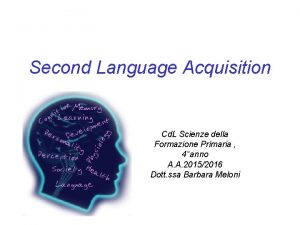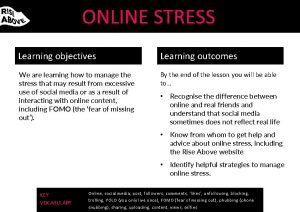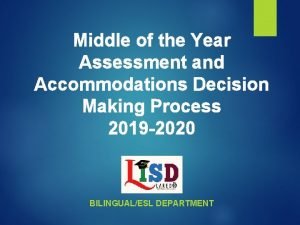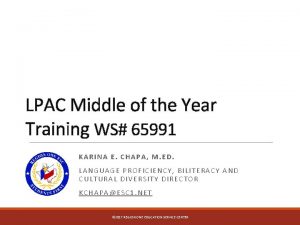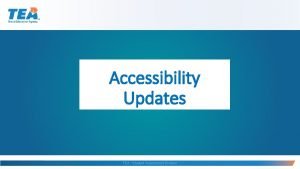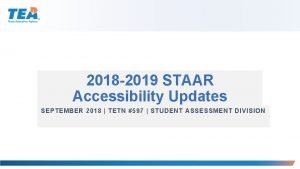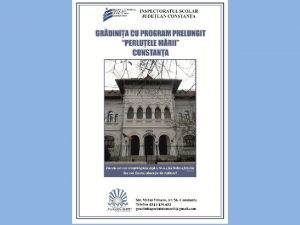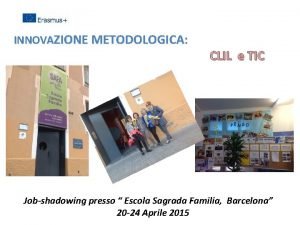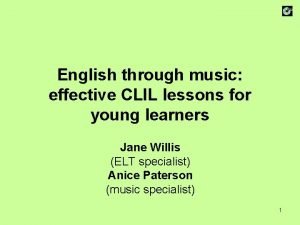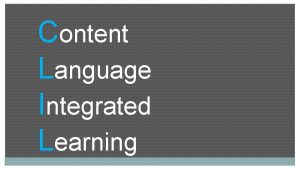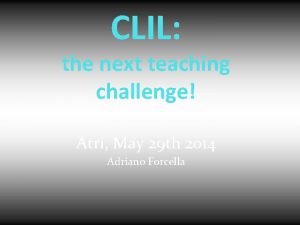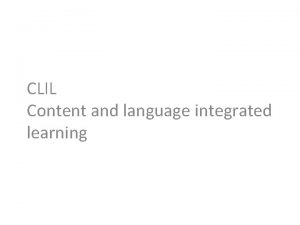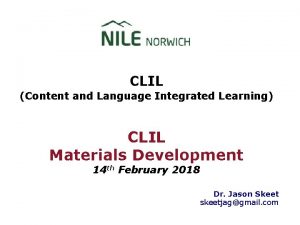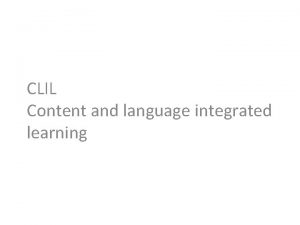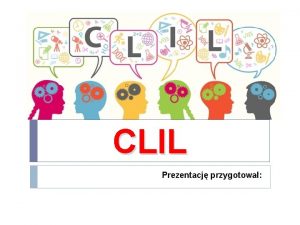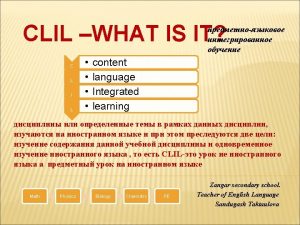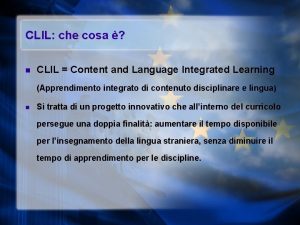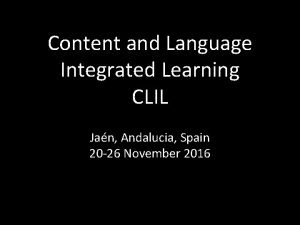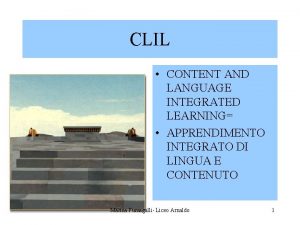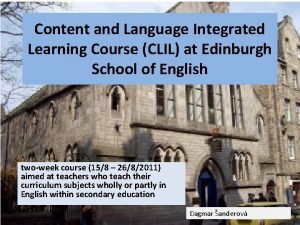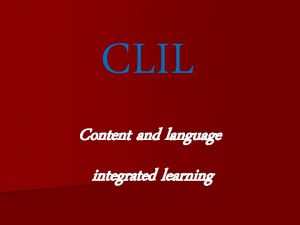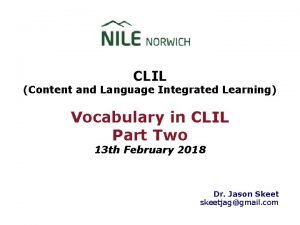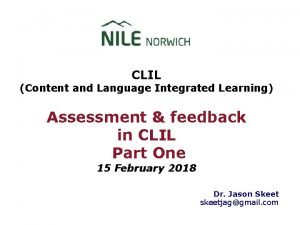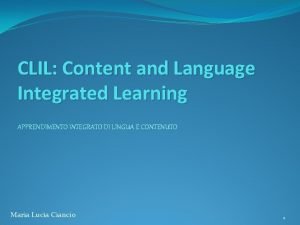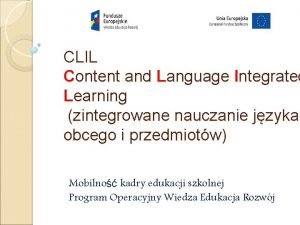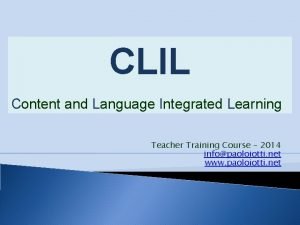CLIL Content and Language Integrated Learning Model CLIL


















- Slides: 18

CLIL (Content and Language Integrated Learning) Model CLIL lesson 12 February 2018 Dr. Jason Skeet skeetjag@gmail. com

WALT • Apply key elements of effective CLIL lesson planning. • Know some of theory behind CLIL lesson planning. • Guide understanding in different ways and in phases.

The ‘three course meal’ CLIL lesson plan • Starter: activates prior knowledge. • Main course: controlled practice and application of new knowledge and skills. • Dessert: reviews and reflects on what has been learned, agreeing and summarising this learning.

Starter Activating language and content Activities that build on each other… Main course(s) (e. g. pre-reading tasks…reading task…) Moving from general to specific… from word level to text level… from Lower Order Thinking Skills to Higher Order Thinking Skills Steps (with support or scaffolding) Dessert Reflection task Review of the learning outcomes

Geography CLIL lesson - 70 minute lesson - Average level B 2 We are learning to… 1. Find out what we already know about Bangladesh in a true or false game. 2. Define topic-specific words and terms to do with flooding in Bangladesh. 3. Rank the causes of flooding in Bangladesh. 4. Extract information from a text in order to explain a flood prevention strategy using key terms and supporting examples.

Learning objective 1: Find out what we already know about the topic True or false? Put up either a red or green card. 1. Bangladesh used to be West Pakistan (False: East Pakistan) 2. Bangladesh is a part of India (False) 3. The population of Bangladesh is 200 million. (False 150 m. ) 4. The capital of Bangladesh is Dhaka. (True) 5. Bangladesh has many mountains. (False, mostly deltas)

Learning objective 1: Find out what we already know about the topic True or false? Put up either a red or green card. 6. It gets very hot in Bangladesh. (True) 7. You can see a rhinoceros in Bangladesh. (True) 8. Most people in Bangladesh are Muslim. (True) 9. 50% of the pupulation in Bangladesh can read and write. (False, 35%) 10. People eat a lot of pasta in Bangladesh. (False – rice)

Alternative starter activity With a partner, use the Venn diagram to write down all the similarities and differences you can think of between where you live and Bangladesh. Where you live Bangladesh

Rationale for lesson starters • Raise interest – increases motivation • Set expectations - making clear to the learner what they can expect from the lesson – this helps the adolescent brain • Build on prior knowledge • Introduce new vocabulary • Opportunity to activate language use

Main course activity: Vocabulary task • • • Global warming Deforestation Sea level Cyclones Storm surges Monsoon In groups: discuss the meanings of the words above and how you think they are going to be used in the next activity.

Main course activity 2: Ranking task In your groups, discuss the physical causes of extreme flooding in Bangladesh. Look at the reasons below, then indicate their order of importance.

Rationale for main course task: Ranking exercise • Making key language salient • Ranking – supporting thinking skills • Enhancing peer communication • Working at a sentence level

Main course activity 3: Cooperative reading using a fishbone diagram In your groups, A reads section 1, B reads section 2, C reads section 3, D reads section 4.

Rationale for main course task: Fishbone • Cooperative learning — enhancing peer communication • Scaffolding learning (the fishbone graphic organizer) — supporting student (written and spoken) output • Engages everyone at a text level

The Dessert: Reflection task • Select a group of learners to give a summary of the lesson. • Ask learners to write down key words from the lesson, and to make sentences with these. • Ask learners to write an important question to ask the rest of the class to test their understanding of the lesson.

Resources for Graphic Organizers • • http: //my. hrw. com/nsmedia/intgos/html/igo. htm http: //www. gliffy. com/ http: //www. classtools. net/education-gamesphp/fishbone http: //www. visualliteracy. org/periodic_table. ht ml#

Summing up… • You can apply key elements of effective CLIL lesson planning • You understand some of theory behind CLIL lesson planning • You can design lessons in phases or steps to support and stimulate learners’ understanding • You can use graphic organizers and visual input to guide understanding

Pyramid of learning: reflecting on the session… One question you want to ask Two activities that have made an impression Three key words that are important
 Carrier content and real content in esp
Carrier content and real content in esp Static content vs dynamic content
Static content vs dynamic content Cuadro comparativo de e-learning b-learning y m-learning
Cuadro comparativo de e-learning b-learning y m-learning What is the language in
What is the language in Content and learning outcome examples
Content and learning outcome examples Pac learning model in machine learning
Pac learning model in machine learning Pac learning model in machine learning
Pac learning model in machine learning Staar alt 2 justification examples
Staar alt 2 justification examples Staar content and language supports
Staar content and language supports What are accessibility features for staar
What are accessibility features for staar Staar content and language supports
Staar content and language supports Second language acquisition vs foreign language acquisition
Second language acquisition vs foreign language acquisition Esempio di lezione clil diritto
Esempio di lezione clil diritto Cele 4 componente ale metodei clil
Cele 4 componente ale metodei clil Tic e clil
Tic e clil Clil music lesson plan
Clil music lesson plan Clil definition
Clil definition Clil matrix
Clil matrix Clil meaning
Clil meaning



